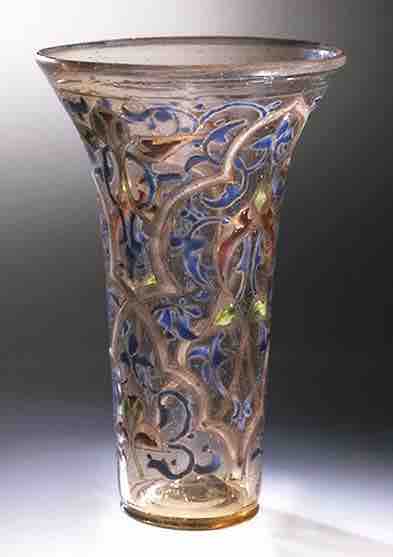Islamic glass
For most of the Middle Ages, Islamic luxury glass was the most sophisticated in Eurasia, exported to both Europe and China. Islam took over much of the traditional glass-producing territory of Sassanian and Ancient Roman glass, and since figurative decoration played a small part in pre-Islamic glass, the change in style was not abrupt—except that the whole area initially formed a political whole, and, for example, Persian innovations were now almost immediately taken up in Egypt. For this reason it is often impossible to distinguish between the various centers of production (of which Egypt, Syria, and Persia were the most important), except by scientific analysis of the material, which itself has difficulties. From various documentary references, glassmaking and glass-trading seems to have been a specialty of the Jewish minority.
Between the 8th and early 11th centuries, the emphasis in luxury glass was on effects achieved by "manipulating the surface" of the glass, initially by incising into the glass on a wheel, and later by cutting away the background to leave a design in relief. The very massive Hedwig glasses, only found in Europe, but normally considered Islamic (or possibly from Muslim craftsmen in Norman Sicily), are an example of this, though puzzlingly late in date. These and other glass pieces probably represented cheaper versions of vessels of carved rock crystal (clear quartz)—themselves influenced by earlier glass vessels—and there is some evidence that at this period glass and hardstone cutting were regarded as the same craft. From the 12th century, the industry in Persia and Mesopotamia appears to decline, and the main production of luxury glass shifts to Egypt and Syria. Throughout the period, local centers made simpler wares such as Hebron glass in Palestine .

"The Luck of Edenhall," a 13th-century Syrian beaker, in England since the Middle Ages.
For most of the Middle Ages, Islamic glass was the most sophisticated in Eurasia, exported to both Europe and China.
Lustre painting
Lustre painting, by techniques similar to lustreware in pottery, dates back to the 8th century in Egypt, and involved the application of metallic pigments during the glass making process. Another technique used by artisans was decoration with threads of glass of a different color, worked into the main surface, and sometimes manipulated by combing and other effects. Gilded, painted, and enameled glass were added to the repertoire, as were shapes and motifs borrowed from other media, such as pottery and metalwork. Some of the finest work was in mosque lamps donated by a ruler or wealthy man. As decoration grew more elaborate, the quality of the basic glass decreased, and it often exhibited bubbles and a brownish-yellow tinge. Aleppo ceased to be a major center after the Mongol invasion of 1260, and Timur appears to have ended the Syrian industry around 1400 by carrying off the skilled workers to Samarkand. By about 1500, the Venetians were receiving large orders for mosque lamps.. Another technique used by artisans was decoration with threads of glass of a different color, worked into the main surface, and sometimes manipulated by combing and other effects. Gilded, painted, and enameled glass were added to the repertoire, as were shapes and motifs borrowed from other media, such as pottery and metalwork. Some of the finest work was in mosque lamps donated by a ruler or wealthy man. As decoration grew more elaborate, the quality of the basic glass decreased, and it often exhibited bubbles and a brownish-yellow tinge. Aleppo ceased to be a major center after the Mongol invasion of 1260, and Timur appears to have ended the Syrian industry around 1400 by carrying off the skilled workers to Samarkand. By about 1500, the Venetians were receiving large orders for mosque lamps.